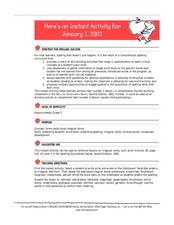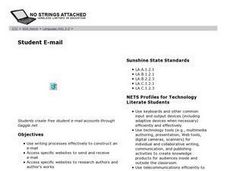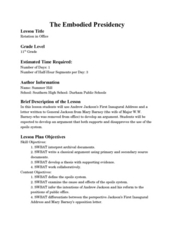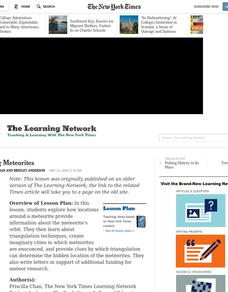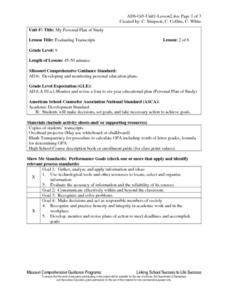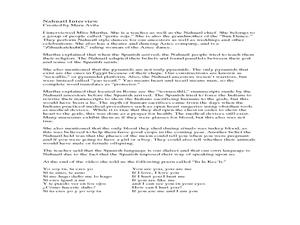Curated OER
We the People: A Study in American Voter Turnout: US Government
Students examine and compare voter turnout in US Elections. They write a letter to a favorite candidate or representative suggesting ways to increase voter turnout.
Curated OER
Feelings From A to Z
Third graders express and interpret information and ideas. They identify a variety of feelings and their effect on people. They explain how someone's actions can cause someone else to have a specific feeling.
Curated OER
Feelings From A to Z
Third graders create a class A to Z Feelings book to explore emotions, discover new words, pose for a "feeling" icture, and write about the feeling.
Curated OER
Pick a Pet
Students design informational materials to educate people on the importance of matching a new pet to the family's lifestyle and living arrangements. Students use critical thinking skills to make a decision on the appropriate choice for a...
Curated OER
Past Tense Irregular Verbs
With this worksheet, youngsters review past tense irregular words and predict the spelling of these words. They complete a worksheet where they fill in the missing letters of irregular verbs. The sheet provides the exact number of spaces...
Curated OER
Student E-mail
Guide your pupils through the process of creating a free e-mail account on Gaggle.net. Once the accounts are established, class members contact authors and practice letter writing techniques. This lesson includes resource links and is...
Curated OER
Lights, Camera...Ticket...2
Students research the pros and cons of traffic light cameras that generate tickets and interview local city officials to see if they have considered this for the community. Students then prepare a panel to present the advantages and...
Curated OER
To Go Solar or Not to Go Solar!
Middle schoolers imagine that they are on a panel to consider if a solar energy system would be advantageous to a new school as it is being built. They read the included handout and then each play a role as a participant in a community...
Curated OER
Who Do You Know?
Students research and describe the contributions of African-American men and women. They write their notes in a Microsoft Word document. They present their information to the class.
Curated OER
Magical Maps
Second graders discuss the importance of using maps and how they are used. After they listen to a folktale, they develop their own story line maps and write their own folktale to accompany a map. They also identify and locate the seven...
Curated OER
Rotation in Office
Eleventh graders explore the concept of the spoils system. In this presidential history lesson, 11th graders examine Andrew Jackson's Inaugural Address as well as a letter to him from Mary Barney in order to gain an understanding of the...
Curated OER
Holidays Around the World
Students explore how different holiday traditions are celebrated around the world. Scholars write a paper describing how they celebrate their own favorite holiday. Email partners, from different states and countries, share their...
Curated OER
Mapping Meteorites
After reading an article, "Cameras Capture a 5-Second Fireball and Its Meteorite's Secrets," space science superstars use the triangulation method to determine the location of a distant object. In-class activities and homework are...
Curated OER
In My Other Life
Students explore various cultural identities. They conduct Internet research, develop a questionnaire that profiles information from their selected culture, and write a letter to a pen pal in the U.S. explaining what life in their...
Curated OER
The Importance of Being Flexible and Open-minded as a Visitor to Another Culture: Lesson 2 For "The Train Ride Home"
Learners examine the advantages of being flexible when visiting or living in a different culture. They read and discuss a first-hand account by a Peace Corps volunteer in Kazakhstan, and write a letter from the point of view of a...
Curated OER
What's Integrity?
Students read a letter by Steve Williams to determine why self-discipline and integrity are important attributes for peace corps volunteers. They apply these concepts to their own lives.
Curated OER
Scribbleboy
Fifth graders are introduced to the text, SCRIBBLEBOY, discussing the cover page for clues to the genre. They discuss the ordinary surroundings contrasted by the graffiti and the words and phrases used to provide information about the...
Curated OER
Dollar Word
Students review the value of coins prior to adding up values to equal one dollar. Letters of the alphabet are assigned monetary values and students use calculators to add up the value of a word. Students work with a partner to try and...
Curated OER
George Winter
Who is George Winter? Learners review knowledge of George Winter, an artist who captured images of the Trail of Tears. They distinguish the difference between primary and secondary sources and determine the reliability of a document....
Curated OER
Evaluating Transcripts
Ninth graders review their transcripts and calculate their individual grade point averages. They brainstorm on how they can keep track of their progress in school and what information will follow them throughout their lives. Each student...
Curated OER
Nahuatl Culture
Students read stories, look at maps, and write journal entries to learn about the language and artwork of Nahuatl culture. For this Nahuatl culture lesson plan, students research the Nahuatl culture and present their findings.
Curated OER
What's Integrity?
Students explore the trait of integrity. In this character education lesson, students read letters by Steve Williams pertaining to jobs that help others. Students discuss the jobs WilIiams shares as well as integrity in their lives.
Curated OER
Beary O'Mometer Learns About Careers In Meteorology
Young scholars explore the field of meteorology. In this meteorology lesson, students explore weather-related careers as they research the field of study as well as various weather concepts. Young scholars interview meteorologists, write...
Virginia Department of Education
Numbers in a Name
What's in a name? Pupils create a data set from the number of letters in the names of classmates. Each group then takes the data and creates a visual representation, such as a histogram, circle graph, stem-and-leaf plot, etc.






